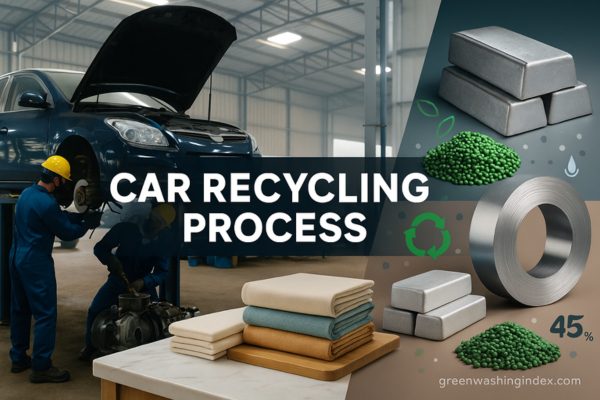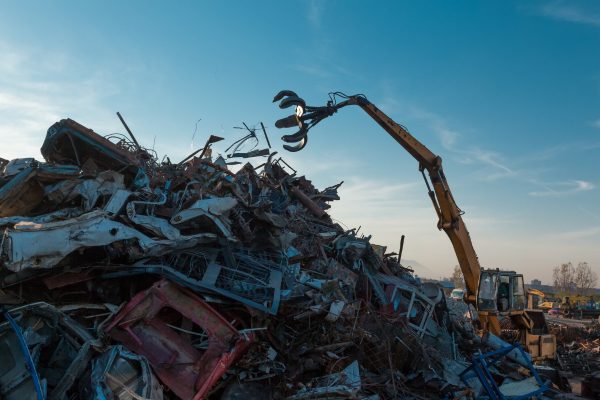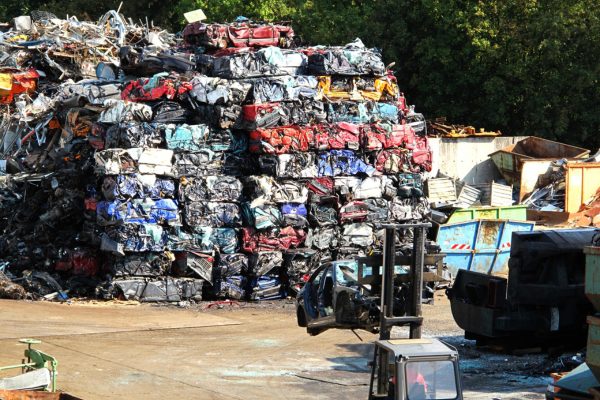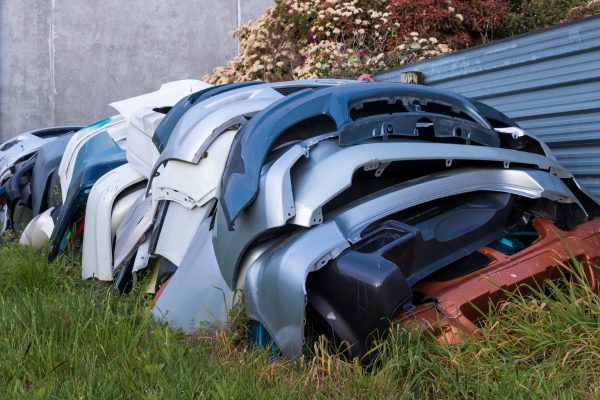

Every year, 12-15 million vehicles reach the end of their useful life in the United States alone, creating a massive environmental challenge that demands immediate attention. The car recycling process has evolved into a sophisticated system that recovers up to 95% of a vehicle’s materials, transforming potential environmental hazards into valuable resources.
Vehicle recycling involves a meticulously planned 10-step process that begins with collection at authorized facilities and ends with materials being reintegrated into manufacturing. This eco-friendly car disposal method prevents toxic substances from contaminating soil and water while conserving precious natural resources. Understanding this process empowers consumers to make informed decisions about their end-of-life vehicles.
This comprehensive guide will walk you through every aspect of automobile recycling, from the initial collection to final material recovery, environmental benefits, regulatory requirements, and practical preparation steps for responsible vehicle disposal.

The car recycling process represents a comprehensive system for dismantling end-of-life vehicles (ELVs) to recover valuable materials and safely dispose of hazardous substances. This intricate procedure transforms what would otherwise be environmental waste into reusable resources for manufacturing new products.
Vehicle recycling meaning extends beyond simple scrap metal recovery. Modern recycling vehicles operations involve sophisticated technology and specialized expertise to separate dozens of different materials. The process ensures that valuable components like engines, transmissions, and electronic modules receive proper evaluation for reuse or remanufacturing.
Recycling cars has become the most successful recycling program for any consumer product. The automotive industry has perfected these techniques over decades, creating an efficient system that handles millions of vehicles annually while maintaining strict environmental standards.
Car recycling environmental benefits extend far beyond waste reduction, addressing critical sustainability challenges facing our planet. When vehicles undergo proper recycling, harmful substances like lead, mercury, and various automotive fluids are prevented from leaching into groundwater systems.
The energy savings from recycling steel alone are remarkable. Metal recycling uses 74% less energy than producing new steel from raw materials. This translates to preventing approximately 85 million barrels of oil consumption annually that would otherwise be required for virgin material production.
Resource conservation represents another crucial environmental advantage. Every recycled car reduces the demand for mining operations that devastate natural habitats. The automotive recycling industry keeps 11 million tons of steel and 800,000 tons of non-ferrous metals out of landfills each year.
The economic implications of car recycling extend throughout multiple industries, creating jobs while reducing manufacturing costs. This sector employs over 140,000 people across 12,500 auto dismantling facilities and 1,800 scrap processing operations in North America alone.
Recycled automotive materials provide cost-effective raw materials for manufacturers. Steel mills rely heavily on recycled car steel, which requires significantly less energy to process than ore-based production. This efficiency translates into lower costs for construction, appliance manufacturing, and new vehicle production.
The automotive recycling industry generates billions of dollars annually through material sales and parts redistribution. Valuable components like catalytic converters, which contain precious metals including platinum and rhodium, contribute significantly to the economic viability of recycling operations.
| Material Type | Recovery Rate | Annual Volume | Economic Value |
|---|---|---|---|
| Steel | 90% | 11 million tons | $3.2 billion |
| Aluminum | 85% | 1.5 million tons | $1.8 billion |
| Copper | 75% | 280,000 tons | $2.1 billion |
| Precious Metals | 95% | 2,200 pounds | $850 million |

The recycling journey begins when end-of-life vehicles are collected and transported to Authorized Treatment Facilities (ATFs). These specialized facilities possess the necessary licenses, equipment, and expertise to handle hazardous materials safely while maximizing material recovery.
Professional collection services ensure vehicles reach certified facilities rather than ending up in illegal dumping sites. Transportation typically involves specialized flatbed trucks or car carriers designed to handle non-operational vehicles safely. Many facilities offer convenient pickup services to encourage proper disposal.
Upon arrival, each vehicle receives a unique identification number for tracking purposes. This documentation system ensures compliance with environmental regulations and provides accountability throughout the entire recycling process.
Comprehensive vehicle assessment determines the most efficient recycling approach for each automobile. Trained technicians evaluate the condition of major components, identifying parts suitable for direct reuse, remanufacturing, or material recovery only.
The inventory process catalogs valuable components including engines, transmissions, electronic modules, and specialty parts. Modern vehicles contain numerous electronic systems that require careful evaluation for potential resale or proper disposal as e-waste.
Assessment teams also identify specific hazardous materials present in each vehicle. Different vehicle makes, models, and years contain varying amounts of mercury switches, refrigerants, and other substances requiring specialized handling procedures.
Systematic fluid extraction represents one of the most critical environmental protection steps in vehicle recycling. Trained technicians remove engine oil, transmission fluid, brake fluid, coolant, and gasoline using specialized equipment designed to prevent spills and contain vapors.
Each automotive fluid requires specific handling and disposal procedures. Used motor oil can be cleaned and refined for reuse, while coolant undergoes treatment to remove contaminants before recycling. Gasoline extraction requires particular caution due to fire and explosion risks.
Refrigerants from air conditioning systems demand especially careful handling due to their ozone-depleting potential. Certified technicians use recovery equipment that captures these substances for proper recycling or disposal according to EPA guidelines.
Strategic parts removal maximizes the value recovered from each vehicle while preparing the shell for final processing. Valuable components like alternators, starter motors, and electronic control modules are carefully extracted for testing and potential resale.
Reusable parts undergo thorough inspection and testing to ensure they meet quality standards for resale. This process includes cleaning, functional testing, and cosmetic evaluation. High-quality used parts provide affordable alternatives for vehicle repairs while extending the useful life of automotive components.
Parts categorization separates components into various streams: direct reuse, remanufacturing candidates, material recovery only, and hazardous waste requiring special disposal. This systematic approach ensures optimal value extraction while maintaining environmental compliance.
The de-pollution process focuses on removing remaining hazardous substances that could contaminate the environment during subsequent processing steps. This includes mercury switches historically used in some vehicles for trunk and hood lighting systems.
Airbag systems require special attention due to the explosive compounds they contain. Trained technicians either deploy airbags safely or remove them intact for specialized disposal. Sodium azide, the primary airbag propellant, poses significant health and environmental risks if not handled properly.
Battery removal and proper handling are essential components of de-pollution. Traditional lead-acid batteries are highly recyclable, while hybrid and electric vehicle batteries require specialized processing due to their complex chemistry and high-voltage systems.
Systematic dismantling recovers valuable materials and components that might otherwise be lost during shredding operations. This labor-intensive process requires skilled technicians who understand automotive construction and material composition.
Appliance recycling techniques inform many automotive dismantling procedures, particularly for electronic components and complex assemblies. Wiring harnesses, for example, contain significant amounts of copper wire that can be recovered through careful removal.
Interior components like seats, dashboard assemblies, and door panels are evaluated for material recovery potential. Modern vehicles contain substantial amounts of recyclable plastics, fabrics, and foam materials that can be processed separately for maximum value recovery.
Vehicle crushing prepares the remaining shell for efficient transportation to shredding facilities. Hydraulic car crushers flatten vehicles into compact cubes or pancakes that maximize trailer capacity while minimizing transportation costs.
The crushing process requires careful preparation to ensure all fluids and hazardous materials have been properly removed. Crushing contaminated vehicles can spread pollutants and create environmental hazards during transportation and subsequent processing.
Crushed vehicles are sorted by material composition and contamination levels before transport. Clean steel shells command higher prices at shredding facilities, while contaminated materials may require additional processing steps that reduce their economic value.
Industrial shredding represents the heart of automotive material recovery, where vehicle shells are reduced to fist-sized fragments in massive machines capable of processing one car every 45 seconds. These powerful shredders use rotating hammers to break down vehicles while built-in systems separate different materials.
The shredding process generates three primary material streams: ferrous metals (iron and steel), non-ferrous metals (aluminum, copper, brass), and automotive shredder residue (ASR) containing plastics, rubber, glass, and fabrics. Each stream requires different processing techniques for optimal material recovery.
Advanced shredding facilities incorporate sophisticated separation technologies including magnetic separators, eddy current separators, and air classification systems. These technologies achieve remarkable purity levels in separated materials, ensuring they meet quality standards for manufacturing applications.
Post-shredding separation employs multiple technologies to isolate different materials with high precision. Magnetic separation easily extracts ferrous metals, which represent approximately 70% of a vehicle’s weight and provide the highest economic value for recycling operations.
Non-ferrous metal recovery utilizes eddy current separation technology that generates electromagnetic fields to repel aluminum, copper, and other conductive materials. This process achieves separation efficiencies above 95% for most non-ferrous metals.
Advanced facilities use optical sorting, density separation, and manual sorting to recover additional materials from automotive shredder residue. Technologies like near-infrared spectroscopy can identify different plastic types, enabling more sophisticated material recovery from complex waste streams.
Final processing prepares recovered materials for sale to manufacturers and processors worldwide. Steel and iron are typically sold directly to steel mills where they’re melted down and reformed into new products including automotive components, construction materials, and appliances.
Non-ferrous metals undergo additional processing to achieve the purity levels required by different industries. Aluminum recovery is particularly valuable since recycled aluminum requires 95% less energy than primary production from bauxite ore.
Plastic recovery from automotive shredder residue continues to improve as new technologies emerge. Some facilities now convert mixed plastics into fuel through pyrolysis processes, while others separate specific plastic types for remanufacturing into automotive components.

Authorised Treatment Facilities represent the official designation for licensed car recycling operations in many jurisdictions. These facilities must meet strict environmental standards and maintain proper permits for handling hazardous materials and end-of-life vehicles.
ATFs undergo regular inspections to ensure compliance with environmental regulations and safety standards. They must demonstrate proper equipment for fluid handling, hazardous material storage, and waste management. Only ATFs are legally authorized to issue certificates of destruction for scrapped vehicles.
The ATF designation provides consumers with assurance that their vehicles will be processed responsibly. These facilities maintain detailed records of all processed vehicles and must report their activities to environmental regulatory agencies.
Auto dismantling yards focus primarily on parts recovery and resale, operating more like automotive parts suppliers than traditional scrap operations. These facilities carefully extract valuable components for testing, refurbishment, and resale to repair shops and individual consumers.
Wrecking yards, by contrast, traditionally focused on scrap metal recovery with limited parts harvesting. Modern operations often combine both approaches, maximizing value through comprehensive parts recovery before final material processing.
The terminology distinction reflects different business models and processing approaches. However, many facilities now operate as full-service recycling centers that combine parts recovery, material processing, and environmental compliance under one operation.
Vehicle recycling centers represent comprehensive facilities that handle the complete end-of-life vehicle processing cycle. These operations typically combine initial assessment, parts recovery, fluid handling, and material processing capabilities in integrated facilities.
Modern recycling centers invest heavily in technology and training to maximize material recovery while minimizing environmental impact. Many facilities achieve recycling rates exceeding 85% through sophisticated processing techniques and comprehensive material recovery programs.
The integration of multiple processing steps allows recycling centers to capture value throughout the entire vehicle lifecycle. This comprehensive approach provides better economics while ensuring environmental compliance across all processing phases.
Locating licensed recycling facilities requires verification of proper permits and environmental compliance records. State environmental agencies maintain databases of authorized facilities that can legally process end-of-life vehicles in their jurisdictions.
Professional associations like the Automotive Recyclers Association provide directories of member facilities that adhere to industry best practices. These organizations promote environmental responsibility and professional standards throughout the automotive recycling industry.
Online resources and local government websites offer tools for locating certified recycling facilities in specific areas. Always verify licensing and insurance before delivering vehicles to ensure proper processing and legal compliance.

Car recycling plays a crucial role in preventing environmental contamination from hazardous substances commonly found in vehicles. Without proper processing, automotive fluids like motor oil, transmission fluid, and brake fluid can seep into soil and groundwater systems, creating long-lasting environmental damage.
Lead contamination represents a particularly serious concern with improperly disposed vehicles. Older vehicles contain lead in various components including wheel weights, batteries, and some electronic systems. Professional recycling ensures these materials are handled safely and kept out of the environment.
Mercury contamination poses another significant threat from vehicles manufactured before 2003. These vehicles often contain mercury switches in convenience lighting and anti-lock braking systems. Proper recycling recovers this mercury for safe processing rather than allowing it to escape into the environment.
The energy savings from car recycling are substantial and measurable. Steel recycling requires approximately 74% less energy than producing new steel from iron ore, translating to massive reductions in fossil fuel consumption and greenhouse gas emissions.
Aluminum recycling provides even greater energy savings, requiring 95% less energy than primary aluminum production. Since modern vehicles contain increasing amounts of aluminum components, these energy savings continue to grow as vehicle designs evolve toward lighter materials.
The cumulative energy savings from automotive recycling are equivalent to powering approximately 18 million households for one year. This represents a significant contribution to energy conservation goals and carbon footprint reduction efforts.
Automotive recycling significantly reduces the demand for mining operations that extract raw materials from the earth. Each recycled vehicle eliminates the need to mine approximately 2,500 pounds of iron ore, 1,400 pounds of coal, and 120 pounds of limestone typically required for steel production.
Precious metal recovery from catalytic converters reduces the environmental impact of mining operations in sensitive ecosystems. These components contain platinum, palladium, and rhodium that would otherwise require environmentally destructive mining processes in remote locations.
The preservation of natural resources extends beyond metals to include rubber, glass, and plastic materials. Each material type recovered through recycling reduces the environmental impact associated with raw material extraction and processing.
Car recycling diverts enormous quantities of material from landfills where they would occupy space for decades without decomposing. The average vehicle contains materials that would persist in landfills for 50-300 years depending on their composition and environmental conditions.
Modern recycling operations achieve diversion rates of 85-95%, meaning only 5-15% of a vehicle’s mass requires landfill disposal. This represents a dramatic improvement over historical practices where entire vehicles were often buried or abandoned.
The reduction in landfill demand helps preserve existing capacity while reducing the need for new landfill construction. This benefit becomes increasingly important as communities struggle with waste management challenges and limited disposal capacity.
| Environmental Benefit | Annual Impact | Measurement Unit |
|---|---|---|
| Steel Saved from Landfills | 11 million | tons |
| Energy Saved | 18 million household equivalent | annual usage |
| Oil Consumption Prevented | 85 million | barrels |
| CO2 Emissions Avoided | 45 million | tons |
Modern vehicles contain numerous hazardous substances that require specialized handling during the recycling process. Lead represents one of the most concerning materials, found in batteries, some electronic components, and wheel weights in older vehicles.
Mercury contamination occurs primarily in vehicles manufactured before 2003, where it was used in convenience lighting switches and some anti-lock braking system components. Even small amounts of mercury can cause significant environmental contamination if not properly handled.
Cadmium appears in some electronic components and certain metal plating applications. While less common than lead or mercury, cadmium poses serious health risks and requires proper identification and handling during the dismantling process.
Automotive fluid management requires specialized equipment and training to prevent environmental contamination and worker exposure. Engine oil, the most common automotive fluid, can contaminate up to one million gallons of water if improperly disposed.
Transmission fluid and hydraulic fluids contain additives that can be harmful to both human health and the environment. These fluids require collection in closed systems that prevent vapor release and contamination of other materials.
Brake fluid presents particular challenges due to its hygroscopic nature and corrosive properties. Proper collection and storage prevent these characteristics from causing additional safety hazards during processing operations.
Lead-acid battery recycling represents one of the most successful recycling programs in any industry, with recovery rates exceeding 95%. However, these batteries require careful handling due to the sulfuric acid electrolyte and lead components they contain.
Hybrid and electric vehicle batteries present new challenges due to their complex chemistry and high-voltage systems. Lithium-ion battery recycling requires specialized facilities with expertise in handling these advanced energy storage systems.
Electronic components throughout modern vehicles contain various hazardous materials including flame retardants, heavy metals, and rare earth elements. These components require evaluation and processing through certified e-waste facilities to ensure proper material recovery and hazard management.
Mercury recovery from automotive sources has become increasingly important as environmental awareness grows. Professional recycling facilities use specialized equipment to extract mercury switches and other mercury-containing components before vehicle processing.
Lead management requires comprehensive procedures throughout the recycling process. From initial battery removal to final material sorting, lead contamination prevention protects both workers and the environment from this persistent toxic metal.
The automotive recycling industry has developed sophisticated tracking and reporting systems for mercury and lead management. These systems ensure regulatory compliance while maximizing recovery of these valuable but hazardous materials.
Conventional internal combustion engine vehicles follow well-established recycling procedures that have been refined over decades. These vehicles contain relatively predictable material compositions and hazardous substance types, making them the most straightforward to process.
Gasoline-powered vehicles typically contain standard automotive fluids, lead-acid batteries, and conventional catalytic converters. The processing procedures for these components are well-documented and widely understood throughout the recycling industry.
Material recovery rates for traditional vehicles consistently achieve 85-90% by weight, with the remaining materials consisting primarily of automotive shredder residue containing mixed plastics, rubber, and fabric components.
Electric vehicles present unique challenges due to their high-voltage battery systems and specialized electronic components. These vehicles require technicians with specific training in high-voltage safety procedures and specialized equipment for safe battery removal.
The lithium-ion battery packs in electric vehicles contain valuable materials including lithium, cobalt, nickel, and rare earth elements. However, these batteries also present fire and toxic gas hazards if not handled properly during the recycling process.
Electric motors contain powerful rare-earth magnets that are valuable for recycling but require specialized knowledge for safe removal. These magnets can cause serious injury if not handled with appropriate tools and techniques.
Hybrid vehicles combine the complexity of both conventional and electric powertrains, requiring expertise in handling both systems safely. These vehicles contain both traditional automotive fluids and high-voltage electrical systems that demand specialized processing procedures.
The dual powertrain systems in hybrid vehicles often result in more complex dismantling procedures and longer processing times. However, they also contain valuable materials from both conventional and electric vehicle technologies.
Hybrid vehicle batteries, while smaller than those in pure electric vehicles, still require specialized handling and processing through certified facilities equipped for advanced battery recycling.
Commercial vehicles and buses present scale challenges due to their size and weight, but follow similar fundamental recycling principles. These vehicles often contain larger quantities of fluids and more robust components that may have higher reuse value.
Fleet vehicles often undergo more regular maintenance, potentially resulting in components with longer remaining useful life. This factor can increase the economic value of parts recovery from commercial vehicle recycling operations.
The larger scale of commercial vehicles may require specialized equipment for handling and processing. However, the increased material quantities can improve the economics of recycling operations for these vehicle types.
End-of-Life Vehicle legislation establishes comprehensive frameworks for vehicle recycling that prioritize environmental protection and resource recovery. These regulations typically mandate minimum recycling rates, currently set at 95% by weight in European Union countries.
ELV legislation places responsibility on vehicle manufacturers to design products with end-of-life considerations and to support recycling infrastructure development. This producer responsibility approach encourages sustainable design practices and recycling technology advancement.
Compliance with ELV legislation requires detailed record-keeping and reporting by recycling facilities. These requirements ensure accountability and provide data for monitoring the effectiveness of recycling programs and identifying improvement opportunities.
The Environmental Protection Agency provides comprehensive guidelines for proper vehicle disposal that emphasize environmental protection and public health safety. These guidelines address hazardous material handling, facility permitting, and waste management requirements.
EPA regulations require proper management of automotive fluids, refrigerants, mercury switches, and other hazardous materials found in end-of-life vehicles. Facilities must demonstrate appropriate equipment and procedures for handling these substances safely.
Enforcement of EPA guidelines includes regular facility inspections and penalties for non-compliance. These enforcement mechanisms ensure that recycling operations maintain environmental standards and protect community health and safety.
Individual states often implement additional requirements beyond federal regulations, creating a complex regulatory environment for automotive recycling operations. These requirements may address facility licensing, worker training, or specific handling procedures for certain materials.
Some states have implemented extended producer responsibility programs that place additional obligations on vehicle manufacturers for end-of-life management. These programs often include funding mechanisms for recycling infrastructure and public education initiatives.
State environmental agencies typically maintain databases of licensed facilities and provide oversight for compliance with both state and federal requirements. These agencies often serve as the primary point of contact for consumers seeking certified recycling services.
International standards for car recycling promote consistent practices across borders while accommodating different regulatory environments and economic conditions. Organizations like the International Organization for Standardization develop these voluntary standards.
Global automotive manufacturers increasingly design vehicles with international recycling standards in mind, facilitating efficient processing regardless of where vehicles reach their end-of-life. This standardization benefits both manufacturers and recycling operations worldwide.
International cooperation on recycling standards also addresses the global trade in recycled materials and ensures that materials recovered in one country meet quality standards for use in manufacturing operations elsewhere.

Steel recovery represents the largest economic component of automotive recycling, generating billions of dollars annually in material sales. The steel industry relies heavily on recycled automotive steel, which provides approximately 25% of total steel production raw materials.
Recycled automotive steel commands premium prices due to its consistent quality and low contamination levels. Car bodies provide clean steel feedstock that requires minimal processing before use in new steel production, making it highly valuable to steel manufacturers.
The economic value of steel recovery continues to grow as global steel demand increases and raw material costs rise. This trend makes automotive recycling increasingly profitable while supporting the economic viability of recycling operations.
Catalytic converter recycling generates substantial economic value due to the precious metals these components contain. A typical catalytic converter contains 3-7 grams of platinum group metals including platinum, palladium, and rhodium.
The value of precious metals in catalytic converters fluctuates with commodity markets but consistently represents one of the highest-value components in vehicle recycling. Current market conditions often result in catalytic converters worth $50-$300 depending on their size and metal content.
Professional recycling operations use specialized equipment to extract and refine precious metals from catalytic converters. This processing requires expertise and specialized facilities but generates excellent returns on investment.
Aluminum recovery from vehicles provides excellent economic returns due to the high value of recycled aluminum and its energy-efficient processing characteristics. Modern vehicles contain increasing amounts of aluminum components, making this material stream increasingly valuable.
Copper extraction focuses primarily on wiring harnesses and electrical components that contain substantial amounts of high-grade copper wire. CRT monitor recycling techniques inform many copper recovery procedures from electronic components.
The economic value of non-ferrous metal recovery continues to increase as these materials become more prevalent in modern vehicle designs. Advanced separation technologies improve recovery rates and material purity, enhancing economic returns.
Plastic recovery from automotive applications has become increasingly sophisticated as new technologies improve material identification and separation capabilities. Different plastic types require different processing approaches, but all can potentially generate economic value through proper handling.
Rubber recycling includes both tire recycling and various rubber components throughout vehicles. While tire recycling represents a separate industry, other rubber components can be processed through automotive recycling operations for material recovery.
The economics of plastic and rubber recovery continue to improve as oil prices increase and environmental regulations create demand for recycled materials. These trends make comprehensive material recovery increasingly profitable for recycling operations.
| Material Category | Average Vehicle Content | Current Market Value | Recovery Rate |
|---|---|---|---|
| Steel | 65% (2,400 lbs) | $350-500/ton | 90% |
| Aluminum | 8% (300 lbs) | $1,200-1,800/ton | 85% |
| Copper | 1.5% (55 lbs) | $7,000-9,000/ton | 75% |
| Precious Metals | <0.1% (0.25 oz) | $20,000-50,000/oz | 95% |
One of the most serious mistakes in car recycling involves improper handling of automotive fluids, which can cause severe environmental contamination and legal liability. Simply draining fluids onto the ground or into storm drains can contaminate groundwater and violate numerous environmental regulations.
Many people underestimate the environmental impact of small fluid quantities. Just one gallon of motor oil can contaminate up to one million gallons of water, making proper collection and disposal absolutely critical for environmental protection.
Professional recycling facilities use specialized equipment to capture, contain, and process automotive fluids safely. This equipment prevents spills and ensures fluids are either recycled or disposed of through appropriate channels according to environmental regulations.
Illegal vehicle dumping creates serious environmental hazards while exposing violators to substantial legal penalties including fines, cleanup costs, and potential criminal charges. Abandoned vehicles often leak fluids and release hazardous materials into the environment over time.
The cleanup costs for illegally dumped vehicles can exceed several thousand dollars per vehicle, including hazardous material remediation, environmental restoration, and proper disposal fees. These costs are typically passed on to the responsible party through legal action.
Law enforcement agencies increasingly use forensic techniques to identify individuals responsible for illegal dumping. Vehicle identification numbers, personal items, and other evidence can lead to prosecution and significant financial penalties.
Working with unlicensed recycling facilities creates legal liability and environmental risks while potentially violating local regulations. These operations may not have proper insurance, environmental permits, or hazardous material handling capabilities.
Unlicensed facilities often offer higher payments for vehicles but achieve these prices by cutting corners on environmental compliance and proper processing procedures. The apparent savings can result in significant legal and environmental consequences for vehicle owners.
Verification of proper licensing takes only a few minutes but provides important protection against legal liability and ensures environmental compliance. State environmental agencies maintain databases of licensed facilities that can be easily accessed online.
Vehicle owners frequently forget to remove personal items and important documentation before recycling, resulting in potential identity theft risks and lost valuable items. A systematic approach to vehicle preparation prevents these problems.
Important documents like registration, insurance papers, and maintenance records should be removed and stored safely. These documents contain personal information that could be misused if not properly secured before vehicle disposal.
Personal items including garage door openers, toll road transponders, and GPS systems contain information that could compromise home security. Cell phone recycling principles apply to any electronic devices left in vehicles during recycling.
Emerging technologies are revolutionizing material separation capabilities in automotive recycling, enabling recovery of materials that were previously considered unrecyclable. Advanced optical sorting systems can now identify and separate different plastic types with remarkable accuracy.
Sensor-based sorting technologies use near-infrared spectroscopy, X-ray fluorescence, and other techniques to identify materials at the molecular level. These technologies enable automated separation of complex material mixtures that previously required manual sorting.
Artificial intelligence integration with sorting systems continues to improve separation accuracy and processing speed. Machine learning algorithms can identify patterns and optimize separation parameters in real-time, maximizing material recovery rates.
AI applications in automotive recycling range from inventory management and parts identification to process optimization and quality control. Computer vision systems can identify valuable components and assess their condition more quickly and accurately than human operators.
Predictive maintenance systems use AI to optimize equipment performance and reduce downtime in recycling operations. These systems analyze equipment data to predict maintenance needs and prevent unexpected failures that can disrupt operations.
Machine learning algorithms analyze market data and material flows to optimize processing decisions and maximize economic returns. These systems can adjust processing parameters based on current market conditions and material values.
Automotive manufacturers increasingly design vehicles with end-of-life considerations in mind, using materials and construction techniques that facilitate easier recycling. This design-for-recycling approach improves material recovery rates while reducing processing costs.
Material standardization and marking systems help recycling operations identify and sort materials more efficiently. Clear material identification enables automated sorting systems to achieve higher accuracy and processing speeds.
Modular design approaches facilitate easier disassembly and component separation during recycling. These design strategies reduce labor requirements while improving material recovery rates and recycling economics.
The automotive industry is embracing circular economy principles that emphasize material reuse and recycling throughout the product lifecycle. This approach treats waste materials as valuable resources rather than disposal problems.
Closed-loop recycling systems return materials directly to automotive manufacturing, reducing the need for virgin materials while ensuring consistent quality standards. These systems require close cooperation between manufacturers and recycling operations.
Extended producer responsibility programs place greater emphasis on manufacturers to support recycling infrastructure and design products for easier end-of-life processing. These programs create incentives for sustainable design and recycling technology development.

Proper documentation ensures legal compliance and facilitates smooth processing at recycling facilities. The vehicle title represents the most important document, proving legal ownership and authorizing disposal of the vehicle.
Registration documents and insurance information should be gathered and reviewed before vehicle pickup or delivery. Some facilities require proof of insurance cancellation to ensure no ongoing coverage conflicts exist.
Lien release documentation is necessary for vehicles with outstanding loans or financing. Contact the lienholder to obtain proper release documents before attempting to recycle the vehicle.
Systematic removal of personal items prevents loss of valuable possessions and protects personal information from potential misuse. Check all compartments including glove boxes, center consoles, door pockets, and trunk areas.
Electronic devices require special attention due to their information storage capabilities and potential value. Remove GPS units, radar detectors, dash cameras, and any mobile devices that might be connected to the vehicle’s systems.
Important items often overlooked include garage door openers, toll road transponders, registration and insurance documents, and personal identification items. Create a checklist to ensure thorough removal of all personal property.
While professional recycling facilities handle fluid removal, vehicle owners should be aware of any leaks or unusual conditions that might require special handling. Document any known fluid leaks or spills for facility personnel.
Battery condition affects vehicle handling and transportation safety. Extremely corroded or damaged batteries may require special handling procedures or advance notification to recycling facilities.
Some facilities prefer that owners remove batteries before delivery, while others include battery removal in their processing procedures. Clarify these preferences when arranging recycling services to ensure proper coordination.
Selecting an appropriate recycling facility requires verification of proper licensing, insurance coverage, and environmental compliance. State environmental agencies maintain databases of authorized facilities that meet regulatory requirements.
Facility capabilities vary significantly, with some specializing in parts recovery while others focus on material processing. Match facility capabilities with your vehicle type and specific recycling goals for optimal results.
Professional certifications and industry associations provide additional assurance of facility quality and environmental commitment. Look for facilities that participate in industry organizations and maintain relevant certifications.
The complete car recycling process typically takes 4-6 hours from vehicle arrival to final material separation, though this timeline varies based on vehicle condition and facility procedures. Initial assessment and fluid removal usually occur within the first hour of processing.
Parts removal and evaluation can take 2-4 hours depending on the vehicle’s complexity and the facility’s parts recovery procedures. Vehicles with valuable components may require additional time for thorough evaluation and testing of reusable parts.
Final processing including crushing and shredding typically occurs in batches, so individual vehicles may wait several days between initial processing and final material recovery. However, the active processing time remains consistent regardless of scheduling delays.
Most end-of-life vehicles have some economic value, typically ranging from $150-$1,000 depending on the vehicle’s condition, current scrap metal prices, and local market conditions. Vehicles with functioning catalytic converters generally command higher prices due to their precious metal content.
The payment amount depends on several factors including vehicle weight, current metal commodity prices, and the presence of valuable components. Larger vehicles and those with aluminum components typically generate higher payments than smaller steel-bodied vehicles.
Some facilities offer free pickup services that may reduce the payment amount but provide convenience for vehicle owners. Compare total value including pickup costs when evaluating different recycling options.
Approximately 85-95% of a vehicle’s materials are recyclable, though some components require specialized processing facilities. Metals, glass, and many plastic components can be readily recycled through standard automotive recycling processes.
Certain materials like automotive shredder residue (ASR) containing mixed plastics, rubber, and fabric require specialized processing techniques. Advanced facilities can recover additional materials from ASR, but this processing is more complex and expensive.
Some components including certain electronic modules and composite materials may not be economically recyclable with current technology. However, ongoing technological developments continue to improve material recovery capabilities.
The small percentage of vehicle materials that cannot be recycled typically consists of automotive shredder residue containing mixed materials that are difficult to separate economically. This material historically went to landfills but increasingly undergoes energy recovery processing.
Modern processing techniques including gasification can convert non-recyclable materials into energy, reducing landfill disposal requirements. Some facilities achieve waste-to-energy conversion rates that essentially eliminate landfill disposal needs.
Hazardous materials that cannot be recycled undergo specialized treatment and disposal through certified hazardous waste facilities. These materials never enter standard waste streams and receive appropriate treatment to prevent environmental contamination.
The environmental impact of driving to recycling facilities is generally minimal compared to the benefits of proper vehicle recycling. However, many facilities offer pickup services that eliminate this concern while providing convenience for vehicle owners.
Consider consolidating recycling trips with other errands to maximize efficiency and minimize environmental impact. Many recycling facilities are located near other automotive services, making combined trips practical and efficient.
The fuel cost for delivery is typically minimal compared to the value received for recycling and the environmental benefits achieved. Professional pickup services may reduce payment amounts but provide convenience and eliminate transportation concerns.
The car recycling process represents one of the most successful environmental programs in modern industry, transforming millions of end-of-life vehicles annually into valuable resources while preventing environmental contamination. This sophisticated 10-step system recovers up to 95% of vehicle materials through careful planning, specialized equipment, and expert processing techniques.
Understanding the complete recycling journey from initial collection through final material distribution empowers consumers to make informed decisions about vehicle disposal. The environmental benefits including energy conservation, resource preservation, and contamination prevention make proper recycling essential for sustainable transportation systems.
The economic value generated through automotive recycling supports thousands of jobs while providing cost-effective raw materials for manufacturing industries worldwide. As recycling technologies continue advancing and vehicle designs evolve, these benefits will only continue growing.
Take action today by researching licensed recycling facilities in your area and preparing your end-of-life vehicles for responsible disposal. Choose certified facilities that demonstrate environmental compliance and comprehensive processing capabilities to ensure your vehicle contributes to this vital environmental and economic system.
By supporting professional automotive recycling, you’re participating in one of the most effective resource conservation programs available while protecting environmental and public health for future generations.
